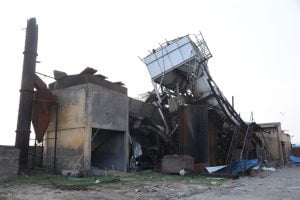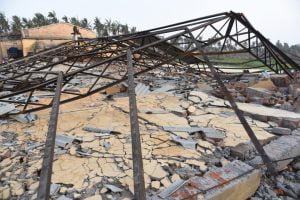Brahmagiri (Puri): Lord Jagannath’s picture frame in office rooms could not withstand Cyclone Fani, says Duryodhan Pagala. Then, pointing at his damaged rice mill, he said: “How could we mortals?” His mill is at Talikabadi Chaak in Odisha’s Brahmagiri, where the eye of the storm passed on May 3.
An innocent reference from a fervent devotee of the Lord, who, he felt, would protect them from this disaster even as the government sounded the warning bell and engaged all machinery to evacuate people to safer places. He admits that faith had made them a little complacent.
When the severe cyclonic storm smacked Odisha, no one had the slightest idea that the ferocious winds would leave behind a catastrophic trail of destruction. A look at the rice mill spread across 2 acres is enough to gauge the intensity of the storm, the strongest since 1999. The huge machines have been damaged beyond repair, the walls have collapsed and the godowns stare straight into the sky with the asbestos roofs having blown away.

Tears rolled down his eyes, as Duryodhan relived those four hours (8.30am to 12.30pm) when Fani barreled though his space, twisting and turning whatever came its way. “We had taken shelter at a pucca house across the road and helplessly watched this dance of Fani. My elder brother Hampal walked down from Puri on hearing the news and fainted on seeing the place in ruins,” he said.
They had set up the mill in 2007. It provided employment to around 200 people, 50 to 100 of them daily-wage labourers. “Fortunately, the mill was closed and no one was inside on the fateful day,” he said, adding that 1.5 lakh quintals of rice was milled per annum at the mill.

“We lost everything to the storm,” he said, pegging the total loss at over Rs 7 crore.
Duryodhan said they had written to the authorities concerned, but was not sure how much of the loss the government would cover.
A little away from this place is another rice mill with roof blown away and paddy sacks lying exposed to elements. “The paddy must have sprouted. Everything has gone waste,” he said.

According to Duryodhan, the storm has pushed Brahmagiri 30 years back. “The houses with thatched roofs and those covered with asbestos and tin have been damaged. Coconut and cashew plantations were the main source of livelihood for people of the area. These have been completely destroyed by Fani,” he said, adding that except for the 1968 floods, the place had never witnessed such fury of nature.
The extremely severe cyclonic storm has left behind a trail of devastation akin to that of 1999 Super Cyclone in Odisha.
“A large number of trees were uprooted, resulting in disruption in road communication and power supply in different districts. There is also extensive damage to dwelling houses. Power supply has snapped as electricity poles have got uprooted and there is damage to sub-stations and high tension overhead electric line. Telecom towers have been damaged, resulting in disruption of cellular and landline phones,” the Chief Secretary’s office had said.
But life goes on and they are slowly picking up the pieces of life to start afresh. “It will take us about three months to dismantle and remove the damaged machines. Though the future is uncertain, we have to find ways to make ends meet,” Duryodhan said.
Tell-tale destruction signs are there for all to see and so is the resilience of the people.


